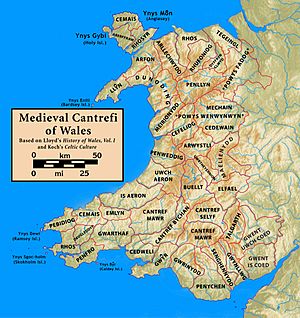Cedewain facts for kids
Cedewain was an important area in medieval Wales. It was part of the ancient Kingdom of Powys. You can think of it like a region or a large district. It had its own local leaders, called lords, and played a role in the history of Wales.
Contents
What was Cedewain?
Cedewain was a type of land division in medieval Wales called a cantref. A cantref was a large area of land, often made up of smaller parts called commotes. Cedewain might have had three commotes named Cynan, Hafren, and Uwch Hanes. Other old records suggest its commotes were Cedewain, Eginlle, and Ceri.
Where was Cedewain Located?
Cedewain was in the southern part of the Kingdom of Powys. To the north, it bordered other cantrefi like Caereinion and Ystlyg, with the River Rhiw forming part of the boundary. To the south, it was next to Arwystli and Maelienydd. The eastern border of Cedewain was the River Severn, which faced England. This location made it an important place for trade and sometimes for battles.
Who Ruled Cedewain?
The lords of Cedewain lived at Dolforwyn Castle. One important lord was Maredudd ap Rhobert. He was the Lord of Cedewain and a chief advisor in Wales. He passed away in 1244 after joining a religious group at Strata Florida Abbey.
In 1260, the town of Knighton was attacked by the lords of Ceri and Cydewain. The next year, Owain ap Maredudd, who was Maredudd ap Rhobert's nephew and the Lord of Cydewain, died. Later, in 1278, Owain's daughter, Angharad, tried to get Cedewain back. She said that Llywelyn ap Gruffudd, who was an enemy of her father, had taken control of the land right after Owain died.
What Happened to Cedewain?
Years later, around 1330-1331, two people named Maredudd ap Madog and Owain ap Madog asked King Edward III to decide who owned Cedewain. At that time, the king controlled Cedewain. They claimed they were the rightful heirs to the land. They said that a powerful family called the Mortimers had taken Cedewain from their ancestors. They also mentioned that Roger Mortimer had let them keep some land near the River Severn. However, his son, Edmund, had taken that land too.


